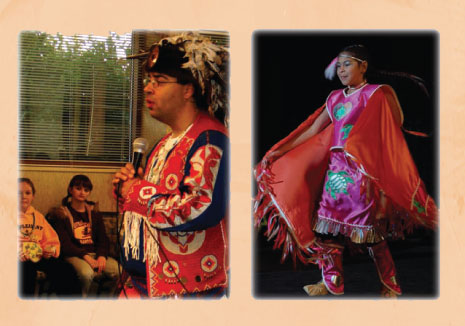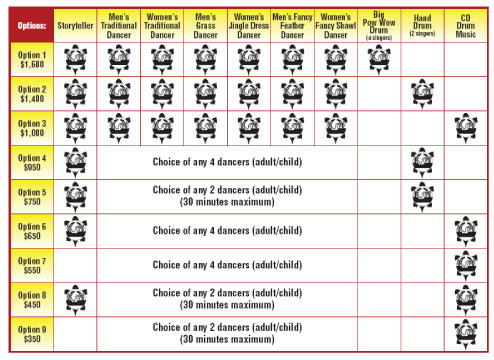6650 E. Broadway • Mt. Pleasant, MI 48858
Phone: 989-775-4750 • Fax: 989-775-4770
Hours Of Operation

Song & Dance Presentations

POW WOW
Dance is an important part of Anishinabe culture. The contemporary Pow Wow is a continuation of our ancestors' traditions, and an expression of contemporary North American Indian identity. Pow Wows provide an opportunity for visitors to be immersed in the sights and sounds of North American Indian cultures. Pow Wows regularly occur around the country and help build a sense of community and solidarity among North American Indians of all nations. The Great Lakes region is home to numerous Pow Wows.
The Ziibiwing Center offers Song & Dance Presentations in order to share the Pow Wow experience with you and your students. This is a great opportunity to learn about the significance of each Pow Wow dance style, and the regalia (specific clothing) worn for each style. The chart below provides a matrix for the various types of Song & Dance Presentations available. Presentations can be customized to meet your school's budget and students' needs. Youth performers may also be requested (subject to availability).

Dance Descriptions

MEN'S TRADITIONAL
This is the oldest form of dance for men. Many say the Men's Traditional Dance tells the story of Creation and how all things on Mother Earth were identified and given names. Other styles of Men's Traditional Dance tell stories of combat and hunting.
WOMEN'S TRADITIONAL
This is the oldest form of dance for women. Women Traditional Dancers' feet never completely leave the Earth. This form of dance honors the connection women share with Mother Earth. Women Traditional Dancers are the "backbone of our nation."
MEN'S GRASS
Long ago, Grass Dance Societies were very important to Woodland and Plains tribes. Men who belonged to these societies were responsible for preparing a ceremonial clearing through dance. Our men still perform this dance today. The regalia of a Grass Dancer represents the movement of blowing grass.
WOMEN'S JINGLE DRESS
This style of dance was born from a young Ojibwe woman's dream to heal her people. Traditionally, 365 tin or copper cones are secured on the dress representing each day of the year. Each cone is filled with a prayer, and as the cones "dance" the prayers are released.
MEN'S FANCY FEATHER
Known for their stamina, high jumps, spins, and fancy footwork, Men's Fancy Dancers literally amaze and excite audiences. This form of dance was born in the early 20th Century. Men's Fancy Feather regalia consists of two multi-colored feather bustles that are worn around the neck and waist.
WOMEN'S FANCY SHAWL
Sometimes called the "Butterfly Dance," the Women's Fancy Shawl Dance began in the mid-20th Century. These women dancers wear brightly colored shawls around their shoulders. Intricate beadwork and dresses match the shawls creating beauty in motion as these dancers perform dazzling footwork and spins.
INTER-TRIBAL & SOCIAL
Everyone is welcome to dance an Inter-tribal Dance...even spectators! It's not as much a particular type of dance as it is a chance for everyone to dance. You don't even need to be in regalia; you can dance in your street clothes. The basic step is where the ball of one foot is tapped on one beat and placed down flatly with the next, repeating the action on the opposite foot without missing a beat. Social dances include the Round dance (which represents friendship and the flow of the human spirit) or the Rabbit Dance/Two Step (a courtship dance where couples dance together holding hands and complete various dance steps.)
Song & Dance Educational Resources
Song & Dance Presentations are an optional part of any group visit. They are also available offsite and may vary in scope, content, and pricing structure. Contact the Visitor Services Coordinator at 1-800-225-8172 ext. 1-54738 or (989) 775-4738 for more information. Please book your program at least 10 business days prior to your event.




